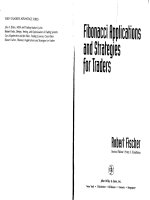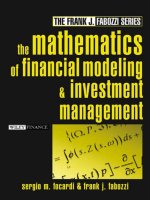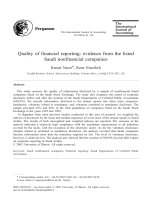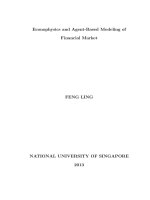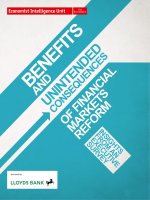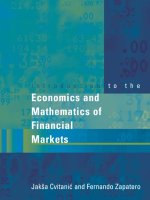robert j , elliott p and ekkehard kopp, «mathematics of financial markets» (springer finance)
Bạn đang xem bản rút gọn của tài liệu. Xem và tải ngay bản đầy đủ của tài liệu tại đây (2.03 MB, 355 trang )
Springer Finance
Editorial Board
M. Avellaneda
G. Barone-Adesi
M. Broadie
M.H.A. Davis
E. Derman
C. Klu
¨
ppelberg
E. Kopp
W. Schachermayer
Robert J. Elliott and P. Ekkehard Kopp
Mathematics of
Financial Markets
Second edition
Robert J. Elliott P. Ekkehard Kopp
Haskayne School of Business Department of Mathematics
University of Calgary University of Hull
Calgary, Alberta Hull HU6 7RX
Canada T2N 1N4 Yorkshire
United Kingdom
With 7 figures.
Library of Congress Cataloging-in-Publication Data
Elliott, Robert J. (Robert James), 1940–
Mathematics of financial markets / Robert J. Elliott and P. Ekkehard Kopp.—2nd ed.
p. cm. — (Springer finance)
Includes bibliographical references and index.
ISBN 0-387-21292-2
1. Investments—Mathematics. 2. Stochastic analysis. 3. Options
(Finance)—Mathematical models. 4. Securities—Prices—Mathematical models.
I. Kopp, P. E., 1944– II. Title. III. Series.
HG4515.3.E37 2004
332.6′01′51—dc22 2004052557
ISBN 0-387-21292-2 Printed on acid-free paper.
© 2005 Springer Science+Business Media Inc.
All rights reserved. This work may not be translated or copied in whole or in part without
the written permission of the publisher (Springer Science+Business Media Inc., 233
Spring Street, New York, NY 10013, USA), except for brief excerpts in connection with
reviews or scholarly analysis. Use in connection with any form of information storage
and retrieval, electronic adaptation, computer software, or by similar or dissimilar meth-
odology now known or hereafter developed is forbidden.
The use in this publication of trade names, trademarks, service marks, and similar terms,
even if they are not identified as such, is not to be taken as an expression of opinion as
to whether or not they are subject to proprietary rights.
Printed in the United States of America. (EB)
987654321 SPIN 10936511
springeronline.com
Preface
This work is aimed at an audience with a sound mathematical background
wishing to learn about the rapidly expanding field of mathematical finance.
Its content is suitable particularly for graduate students in mathematics
who have a background in measure theory and probability.
The emphasis throughout is on developing the mathematical concepts
required for the theory within the context of their application. No attempt
is made to cover the bewildering variety of novel (or ‘exotic’) financial in-
struments that now appear on the derivatives markets; the focus through-
out remains on a rigorous development of the more basic options that lie
at the heart of the remarkable range of current applications of martingale
theory to financial markets.
The first five chapters present the theory in a discrete-time framework.
Stochastic calculus is not required, and this material should be accessible
to anyone familiar with elementary probability theory and linear algebra.
The basic idea of pricing by arbitrage (or, rather, by non-arbitrage)
is presented in Chapter 1. The unique price for a European option in a
single-period binomial model is given and then extended to multi-period
binomial models. Chapter 2 introduces the idea of a martingale measure
for price processes. Following a discussion of the use of self-financing trad-
ing strategies to hedge against trading risk, it is shown how options can
be priced using an equivalent measure for which the discounted price pro-
cess is a martingale. This is illustrated for the simple binomial Cox-Ross-
Rubinstein pricing models, and the Black-Scholes formula is derived as the
limit of the prices obtained for such models. Chapter 3 gives the ‘funda-
mental theorem of asset pricing’, which states that if the market does not
contain arbitrage opportunities there is an equivalent martingale measure.
Explicit constructions of such measures are given in the setting of finite
market models. Completeness of markets is investigated in Chapter 4; in a
complete market, every contingent claim can be generated by an admissible
self-financing strategy (and the martingale measure is unique). Stopping
times, martingale convergence results, and American options are discussed
in a discrete-time framework in Chapter 5.
The second five chapters of the book give the theory in continuous time.
This begins in Chapter 6 with a review of the stochastic calculus. Stopping
times, Brownian motion, stochastic integrals, and the Itˆo differentiation
v
vi Preface
rule are all defined and discussed, and properties of stochastic differential
equations developed.
The continuous-time pricing of European options is developed in Chap-
ter 7. Girsanov’s theorem and martingale representation results are de-
veloped, and the Black-Scholes formula derived. Optimal stopping results
are applied in Chapter 8 to a thorough study of the pricing of American
options, particularly the American put option.
Chapter 9 considers selected results on term structure models, forward
and future prices, and change of num´eraire, while Chapter 10 presents the
basic framework for the study of investment and consumption problems.
Acknowledgments Sections of the book have been presented in courses
at the Universities of Adelaide and Alberta. The text has consequently
benefited from subsequent comments and criticism. Our particular thanks
go to Monique Jeanblanc-Piqu´e, whose careful reading of the text and
valuable comments led to many improvements. Many thanks are also due
to Volker Wellmann for reading much of the text and for his patient work
in producing consistent T
E
X files and the illustrations.
Finally, the authors wish to express their sincere thanks to the Social
Sciences and Humanities Research Council of Canada for its financial sup-
port of this project.
Edmonton, Alberta, Canada Robert J. Elliott
Hull, United Kingdom P. Ekkehard Kopp
Preface to the Second
Edition
This second, revised edition contains a significant number of changes and
additions to the original text. We were guided in our choices by the com-
ments of a number of readers and reviewers as well as instructors using the
text with graduate classes, and we are grateful to them for their advice.
Any errors that remain are of course entirely our responsibility.
In the five years since the book was first published, the subject has con-
tinued to grow at an astonishing rate. Graduate courses in mathematical
finance have expanded from their business school origins to become stan-
dard fare in many mathematics departments in Europe and North America
and are spreading rapidly elsewhere, attracting large numbers of students.
Texts for this market have multiplied, as the rapid growth of the Springer
Finance series testifies. In choosing new material, we have therefore fo-
cused on topics that aid the student’s understanding of the fundamental
concepts, while ensuring that the techniques and ideas presented remain
up to date. We have given particular attention, in part through revisions
to Chapters 5 and 6, to linking key ideas occurring in the two main sections
(discrete- and continuous-time derivatives) more closely and explicitly.
Chapter 1 has been revised to include a discussion of risk and return in
the one-step binomial model (which is given a new, extended presentation)
and this is complemented by a similar treatment of the Black-Scholes model
in Chapter 7. Discussion of elementary bounds for option prices in Chapter
1 is linked to sensitivity analysis of the Black-Scholes price (the ‘Greeks’)
in Chapter 7, and call-put parity is utilised in various settings.
Chapter 2 includes new sections on superhedging and the use of ex-
tended trading strategies that include contingent claims, as well as a more
elegant derivation of the Black-Scholes option price as a limit of binomial
approximants.
Chapter 3 includes a substantial new section leading to a complete proof
of the equivalence, for discrete-time models, of the no-arbitrage condition
and the existence of equivalent martingale measures. The proof, while not
original, is hopefully more accessible than others in the literature.
This material leads in Chapter 4 to a characterisation of the arbitrage
vii
viii Preface to the the Second Edition
interval for general market models and thus to a characterisation of com-
plete models, showing in particular that complete models must be finitely
generated.
The new edition ends with a new chapter on risk measures, a subject
that has become a major area of research in the past five years. We include a
brief introduction to Value at Risk and give reasons why the use of coherent
risk measures (or their more recent variant, deviation measures) is to be
preferred. Chapter 11 ends with an outline of the use of risk measures in
recent work on partial hedging of contingent claims.
The changes we have made to the text have been informed by our
continuing experience in teaching graduate courses at the universities of
Adelaide, Calgary and Hull, and at the African Institute for Mathematical
Sciences in Cape Town.
Acknowledgments Particular thanks are due to Alet Roux (Hull) and
Andrew Royal (Calgary) who provided invaluable assistance with the com-
plexities of LaTeX typesetting and who read large sections of the text.
Thanks are also due to the Social Sciences and Humanities Research Coun-
cil of Canada for continuing financial support.
Calgary, Alberta, Canada Robert J. Elliott
Hull, United Kingdom P. Ekkehard Kopp
May 2004
Contents
Preface v
PrefacetotheSecondEdition vii
1 Pricing by Arbitrage 1
1.1 Introduction:PricingandHedging 1
1.2 Single-PeriodOptionPricingModels 10
1.3 AGeneralSingle-PeriodModel 12
1.4 ASingle-PeriodBinomialModel 14
1.5 Multi-periodBinomialModels 20
1.6 Bounds on Option Prices 24
2 Martingale Measures 27
2.1 AGeneralDiscrete-TimeMarketModel 27
2.2 TradingStrategies 29
2.3 MartingalesandRisk-NeutralPricing 35
2.4 ArbitragePricing:MartingaleMeasures 38
2.5 StrategiesUsingContingentClaims 43
2.6 Example:TheBinomialModel 48
2.7 FromCRRtoBlack-Scholes 50
3 The First Fundamental Theorem 57
3.1 The Separating Hyperplane Theorem in R
n
57
3.2 ConstructionofMartingaleMeasures 59
3.3 Pathwise Description 61
3.4 Examples 69
3.5 GeneralDiscreteModels 71
4 Complete Markets 87
4.1 Completeness and Martingale Representation 88
4.2 CompletenessforFiniteMarketModels 89
4.3 TheCRRModel 91
4.4 TheSplittingIndexandCompleteness 94
4.5 IncompleteModels:TheArbitrageInterval 97
4.6 CharacterisationofCompleteModels 101
ix
x CONTENTS
5 Discrete-time American Options 105
5.1 HedgingAmericanClaims 105
5.2 Stopping Times and Stopped Processes 107
5.3 UniformlyIntegrableMartingales 110
5.4 OptimalStopping:TheSnellEnvelope 116
5.5 PricingandHedgingAmericanOptions 124
5.6 Consumption-InvestmentStrategies 126
6 Continuous-Time Stochastic Calculus 131
6.1 Continuous-Time Processes 131
6.2 Martingales 135
6.3 StochasticIntegrals 141
6.4 The ItˆoCalculus 149
6.5 StochasticDifferentialEquations 158
6.6 MarkovPropertyofSolutionsofSDEs 162
7 Continuous-Time European Options 167
7.1 Dynamics 167
7.2 Girsanov’sTheorem 168
7.3 Martingale Representation 174
7.4 Self-FinancingStrategies 183
7.5 AnEquivalentMartingaleMeasure 185
7.6 Black-ScholesPrices 193
7.7 PricinginaMultifactorModel 198
7.8 BarrierOptions 204
7.9 TheBlack-ScholesEquation 214
7.10TheGreeks 217
8 The American Put Option 223
8.1 ExtendedTradingStrategies 223
8.2 AnalysisofAmericanPutOptions 226
8.3 ThePerpetualPutOption 231
8.4 EarlyExercisePremium 234
8.5 Relation to Free Boundary Problems 238
8.6 AnApproximateSolution 243
9 Bonds and Term Structure 247
9.1 MarketDynamics 247
9.2 FuturePriceandFuturesContracts 252
9.3 Changing Num´eraire 255
9.4 AGeneralOptionPricingFormula 258
9.5 TermStructureModels 262
9.6 Short-rateDiffusionModels 264
9.7 TheHeath-Jarrow-MortonModel 277
9.8 AMarkovChainModel 282
CONTENTS xi
10 Consumption-Investment Strategies 285
10.1 Utility Functions 285
10.2AdmissibleStrategies 287
10.3 Maximising Utility of Consumption 291
10.4 Maximisation of Terminal Utility 296
10.5ConsumptionandTerminalWealth 299
11 Measures of Risk 303
11.1ValueatRisk 304
11.2CoherentRiskMeasures 308
11.3DeviationMeasures 316
11.4HedgingStrategieswithShortfallRisk 320
Bibliography 329
Index 349
Chapter 1
Pricing by Arbitrage
1.1 Introduction: Pricing and Hedging
The ‘unreasonable effectiveness’ of mathematics is evidenced by the fre-
quency with which mathematical techniques that were developed without
thought for practical applications find unexpected new domains of appli-
cability in various spheres of life. This phenomenon has customarily been
observed in the physical sciences; in the social sciences its impact has per-
haps been less evident. One of the more remarkable examples of simulta-
neous revolutions in economic theory and market practice is provided by
the opening of the world’s first options exchange in Chicago in 1973, and
the ground-breaking theoretical papers on preference-free option pricing by
Black and Scholes [27] (quickly extended by Merton [222]) that appeared
in the same year, thus providing a workable model for the ‘rational’ market
pricing of traded options.
From these beginnings, financial derivatives markets worldwide have
become one of the most remarkable growth industries and now constitute
a major source of employment for graduates with high levels of mathemat-
ical expertise. The principal reason for this phenomenon has its origins in
the simultaneous stimuli just described, and the explosive growth of these
secondary markets (whose levels of activity now frequently exceed the un-
derlying markets on which their products are based) continues unabated,
with total trading volume now measured in trillions of dollars. The vari-
ety and complexity of new financial instruments is often bewildering, and
much effort goes into the analysis of the (ever more complex) mathematical
models on which their existence is predicated.
In this book,we present the necessary mathematics, within the con-
text of this field of application, as simply as possible in an attempt to
dispel some of the mystique that has come to surround these models and
at the same time to exhibit the essential structure and robustness of the
underlying theory. Since making choices and decisions under conditions
1
2 CHAPTER 1. PRICING BY ARBITRAGE
of uncertainty about their outcomes is inherent in all market trading, the
area of mathematics that finds the most natural applications in finance
theory is the modern theory of probability and stochastic processes,which
has itself undergone spectacular growth in the past five decades. Given
our current preoccupations, it seems entirely appropriate that the origins
of probability, as well as much of its current motivation, lie in one of the
earliest and most pervasive indicators of ‘civilised’ behaviour: gambling.
Contingent Claims
A contingent claim represents the potential liability inherent in a derivative
security; that is, in an asset whose value is determined by the values of one
or more underlying variables (usually securities themselves). The analysis
of such claims, and their pricing in particular, forms a large part of the
modern theory of finance. Decisions about the prices appropriate for such
claims are made contingent on the price behaviour of these underlying
securities (often simply referred to as the underlying), and the theory of
derivatives markets is primarily concerned with these relationships rather
than with the economic fundamentals that determine the prices of the
underlying.
While the construction of mathematical models for this analysis often
involves very sophisticated mathematical ideas, the economic insights that
underlie the modelling are often remarkably simple and transparent. In
order to highlight these insights we first develop rather simplistic mathe-
matical models based on discrete time (and, frequently, finitely generated
probability spaces) before showing how the analogous concepts can be used
in the more widely known continuous models based on diffusions and Itˆo
processes. For the same reason, we do not attempt to survey the range
of contingent claims now traded in the financial markets but concentrate
on the more basic stock options before attempting to discuss only a small
sample of the multitude of more recent, and often highly complex, finan-
cial instruments that finance houses place on the markets in ever greater
quantities.
Before commencing the mathematical analysis of market models and
the options based upon them, we outline the principal features of the main
types of financial instruments and the conditions under which they are
currently traded in order to have a benchmark for the mathematical ide-
alisations that characterise our modelling. We briefly consider the role of
forwards, futures, swaps, and options.
Forward Contracts A forward contract is simply an agreement to buy
or sell a specified asset S at a certain future time T for a price K that is
specified now (which we take to be time 0). Such contracts are not normally
traded on exchanges but are agreements reached between two sophisticated
institutions, usually between a financial institution such as a bank and one
of its corporate clients. The purpose is to share risk: one party assumes
1.1. INTRODUCTION: PRICING AND HEDGING 3
a long position by agreeing to buy the asset, and the other takes a short
position by agreeing to sell the asset for the delivery price K at the delivery
date T . Initially neither party incurs any costs in entering into the contract,
and the forward price of the contract at time t ∈ [0,T] is the delivery price
that would give the contract zero value. Thus, at time 0, the forward price
is K, but at later times movement in the market value of the underlying
commodity will suggest different values. The payoff to the holder of the
long position at time T is simply S
T
− K, and for the short position it is
K − S
T
. Thus, since both parties are obliged to honour the contract, in
general one will lose and the other gain the same amount.
Trading in forwards is not closely regulated, and the market participant
bears the risk that the other party may default-the instruments are not
traded on an exchange but ‘over-the-counter’ (OTC) worldwide, usually by
electronic means. There are no price limits (as could be set by exchanges),
and the object of the transaction is delivery; that is, the contracts are not
usually ‘sold on’ to third parties. Thus the problem of determining a ‘fair’
or rational price, as determined by the collective judgement of the market
makers or by theoretical modelling, appears complicated.
Intuitively, averaging over the possible future values of the asset may
seem to offer a plausible approach. That this fails can be seen in a simple
one-period example where the asset takes only two future values.
Example 1.1.1. Suppose that the current (time 0) value of the stock is
$100 and the value at time 1 is $120 with probability p =
3
4
and $80 with
probability 1 −p =
1
4
. Suppose the riskless interest rate is r =5%overthe
time period. A contract price of
3
4
×$120 +
1
4
×$80 = $110 produces a 10%
return for the seller, which is greater than the riskless return, while p =
1
2
would suggest a price of $100, yielding a riskless benefit for the buyer.
This suggests that we should look for a pricing mechanism that is inde-
pendent of the probabilities that investors may attach to the different future
values of the asset and indeed is independent of those values themselves.
The simple assumption that investors will always prefer having more to
having less (this is what constitutes ‘rational behaviour’ in the markets)
already allows us to price a forward contract that provides no dividends
or other income. Let S
t
be the spot price of the underlying asset S (i.e.,
its price at time t ∈ [0,T]); then the forward price F(t, T)atthattimeis
simply the value at the time T of a riskless investment of S
t
made at time
t whose value increases at a constant riskless interest rate r>0. Under
continuous compounding at this rate, an amount of money M
s
in the bank
will grow exponentially according to
dM
s
M
s
= rds, s ∈ [t, T].
To repay the loan S
t
taken out at t,wethusneedM
T
= S
t
e
r(T −t)
by
time T .
4 CHAPTER 1. PRICING BY ARBITRAGE
We therefore claim that
F (t, T)=S
t
e
r(T −t)
for t ∈ [0,T] .
To see this, consider the alternatives. If the forward price is higher, we
can borrow S
t
for the interval [t, T] at rate r, buy the asset, and take a
short position in the forward contract. At time T , we need S
t
e
r(T −t)
to
repay our loan but will realise the higher forward price from the forward
contract and thus make a riskless profit. For F(t, T) <S
t
e
r(T −t)
,we
can similarly make a sure gain by shorting the asset (i.e., ‘borrowing’ it
from someone else’s account, a service that brokers will provide subject
to various market regulations) and taking a long position in the contract.
Thus, simple ‘arbitrage’ considerations (in other words, that we cannot
expect riskless profits, or a ‘free lunch’) lead to a definite forward price at
each time t.
Forward contracts can be used for reducing risk (hedging). For example,
large corporations regularly face the risk of currency fluctuations and may
be willing to pay a price for greater certainty. A company facing the need to
make a large fixed payment in a foreign currency at a fixed future date may
choose to enter into a forward contract with a bank to fix the rate now in
order to lock in the exchange rate. The bank, on the other hand, is acting
as a speculator since it will benefit from an exchange rate fluctuation that
leaves the foreign currency below the value fixed today. Equally, a company
may speculate on the exchange rate going up more than the bank predicts
and take a long position in a forward contract to lock in that potential
advantage-while taking the risk of losses if this prediction fails. In essence,
it is betting on future movements in the asset. The advantage over actual
purchase of the currency now is that the forward contract involves no cost at
time 0 and only potential cost if the gamble does not pay off. In practice,
financial institutions will demand a small proportion of the funds as a
deposit to guard against default risk; nonetheless, the gearing involved in
this form of trading is considerable.
Both types of traders, hedgers and speculators, are thus required for
forward markets to operate. A third group, arbitrageurs, typically enter
two or more markets simultaneously, trying to exploit local or temporary
disequilibria (i.e., mispricing of certain assets) in order to lock in riskless
profits. The fundamental economic assumption that (ideal) markets op-
erate in equilibrium makes this a hazardous undertaking requiring rapid
judgements (and hence well-developed underlying mathematical models)
for sustained success-their existence means that assets do not remain mis-
priced for long or by large amounts. Thus it is reasonable to build models
and calculate derivative prices that are based on the assumption of the
absence of arbitrage, and this is our general approach.
Futures Contracts Futures contracts involve the same agreement to
trade an asset at a future time at a certain price, but the trading takes
1.1. INTRODUCTION: PRICING AND HEDGING 5
place on an exchange and is subject to regulation. The parties need not
know each other, so the exchange needs to bear any default risk-hence the
contract requires standardised features, such as daily settlement arrange-
ments known as marking to market. The investor is required to pay an
initial deposit, and this initial margin is adjusted daily to reflect gains and
losses since the futures price is determined on the floor of the exchange by
demand and supply considerations. The price is thus paid over the life of
the contract in a series of instalments that enable the exchange to balance
long and short positions and minimise its exposure to default risk. Futures
contracts often involve commodities whose quality cannot be determined
with certainty in advance, such as cotton, sugar, or coffee, and the delivery
price thus has reference points that guarantee that the asset quality falls
between agreed limits, as well as specifying contract size.
The largest commodity futures exchange is the Chicago Board of Trade,
but there are many different exchanges trading in futures around the world;
increasingly, financial futures have become a major feature of many such
markets. Futures contracts are written on stock indices, on currencies, and
especially on movements in interest rates. Treasury bills and Eurodollar
futures are among the most common instruments.
Futures contracts are traded heavily, and only a small proportion are
actually delivered before being sold on to other parties. Prices are known
publicly and so the transactions conducted will be at the best price available
at that time. We consider futures contracts in Chapter 9, but only in the
context of interest rate models.
Swaps A more recent development, dating from 1981, is the exchange of
future cash flows between two partners according to agreed prior criteria
that depend on the values of certain underlying assets. Swaps can thus
be thought of as portfolios of forward contracts, and the initial value as
well as the final value of the swap is zero. The cash flows to be exchanged
may depend on interest rates. In the simplest example (a plain vanilla
interest rate swap), one party agrees to pay the other cash flows equal to
interest at a fixed rate on a notional principal at each payment date. The
other party agrees to pay interest on the same notional principal and in
the same currency, but the cash flow is based on a floating interest rate.
Thus the swap transforms a floating rate loan into a fixed rate one and
vice versa. The floating rate used is often LIBOR (the London Interbank
Offer Rate), which determines the interest rate used by banks on deposits
from other banks in Eurocurrency markets; it is quoted on deposits of
varying duration-one month, three months, and so on. LIBOR operates as
a reference rate for international markets: three-month LIBOR is the rate
underlying Eurodollar futures contracts, for example.
There is now a vast range of swap contracts available, with currency
swaps (whereby the loan exchange uses fixed interest rate payments on
loans in different currencies) among the most heavily traded. We do not
6 CHAPTER 1. PRICING BY ARBITRAGE
study swaps in this book; see [232] or [305] for detailed discussions. The lat-
ter text focuses on options that have derivative securities, such as forwards,
futures, or swaps, as their underlying assets; in general, such instruments
are known as exotics.
Options An option on a stock is a contract giving the owner the right,
but not the obligation, to trade a given number of shares of a common
stock for a fixed price at a future date (the expiry date T ). A call option
gives the owner the right to buy stocks, and a put option confers the right
to sell, at the fixed strike price K. The option is European if it can only be
exercised at the fixed expiry date T . The option is American if the owner
can exercise his right to trade at any time up to the expiry date. Options
are the principal financial instruments discussed in this book.
In Figures 1.1 and 1.2, we draw the simple graphs that illustrate the
payoff function of each of these options. In every transaction there are two
parties, the buyer and the seller, more usually termed the writer,ofthe
option. In the case of a European call option on a stock (S
t
)
t∈T
with strike
price K at time T , the payoff equals S
T
− K if S
T
>Kand 0 otherwise.
The payoff for the writer of the option must balance this quantity; that is,
it should equal K −S
T
if S
T
<Kand 0 otherwise. The option writer must
honour the contract if the buyer decides to exercise his option at time T .
Fair Prices and Hedge Portfolios
The problem of option pricing is to determine what value to assign to the
option at a given time (e.g. at time 0). It is clear that a trader can make
a riskless profit (at least in the absence of inflation) unless she has paid an
‘entry fee’ that allows her the chance of exercising the option favourably at
the expiry date. On the other hand, if this ‘fee’ is too high, and the stock
price seems likely to remain close to the strike price, then no sensible trader
would buy the option for this fee. As we saw previously, operating on a set
T of possible trading dates (which may typically be a finite set of natural
numbers of the form {0, 1, ,T}, or, alternatively, a finite interval [0,T]
on the real line), the buyer of a European call option on a stock with price
process (S
t
)
t∈T
will have the opportunity of receiving a payoff at time T
of C(t)=max{S
T
− K, 0}, since he will exercise the option if, and only if,
the final price of the stock S
T
is greater than the previously agreed strike
price K.
With the call option price set at C
0
, we can draw the graph of the gain
(or loss) in the transaction for both the buyer and writer of the option.
Initially we assume for simplicity that the riskless interest rate is 0 (the
‘value of money’ remains constant); in the next subsection we shall drop
this assumption, and then account must be taken of the rate at which
money held in a savings account would accumulate. For example, with
continuous compounding over the interval T =[0,T], the price C
0
paid for
theoptionattime0wouldbeworthC
0
e
rT
by time T. With the rate r =0,
1.1. INTRODUCTION: PRICING AND HEDGING 7
C
0
C
0
S
T
S
T
Payoff
Payoff
K
buyer
writer
K
Figure 1.1: Payoff and gain for European call option
the buyer’s gain from the call option will be S
T
− K − C
0
if S
T
>Kand
−C
0
if S
T
≤ K. The writer’s gain is given by K − S
T
+ C
0
if S
T
>K
and C
0
if S
T
≤ K. Similar arguments hold for the buyer and writer of a
European put option with strike K andoptionpriceP
0
. The payoff and
gain graphs are given in Figures 1.1 and 1.2.
Determining the option price entails an assessment of a price to which
both parties would logically agree. One way of describing the fair price for
theoptionisasthecurrent value of a portfolio that will yield exactly the
same return as does the option by time T . Strictly, this price is fair only
for the writer of the option, who can calculate the fair price as the smallest
initial investment that would allow him to replicate the value of the option
throughout the time set T by means of a portfolio consisting of stock and
a riskless bond (or savings account) alone. The buyer, on the other hand,
will want to cover any potential losses by borrowing the amount required
to buy the option (the buyer’s option price) and to invest in the market in
order to reduce this liability, so that at time T the option payoff at least
covers the loan. In general, the buyer’s and seller’s option prices will not
coincide-it is a feature of complete market models, which form the main
topic of interest in this book, that they do coincide, so that it becomes
possible to refer to the fair price of the option. Our first problem is to
determine this price uniquely.
When option replication is possible, the replicating portfolio can be
8 CHAPTER 1. PRICING BY ARBITRAGE
C
0
C
0
S
T
S
T
Payoff
Payoff
buyer
writer
K
K
Figure 1.2: Payoff and gain for European put option
used to offset, or hedge, the risk inherent in writing the option; that is, the
risk that the writer of the option may have to sell the share S
T
for the fixed
price K even though, with small probability, S
T
may be much larger than
K. Our second problem is therefore to construct such a hedge portfolio.
Call-Put Parity
Our basic market assumption enables us to concentrate our attention on
call options alone. Once we have dealt with these, the solutions of the cor-
responding problems for the European put option can be read off at once
from those for the call option. The crucial assumption that ensures this is
that our market model rules out arbitrage; that is, no investor should be
able to make riskless profits, in a sense that we will shortly make more pre-
cise. This assumption is basic to option pricing theory since there can be
no market equilibrium otherwise. It can be argued that the very existence
of ‘arbitrageurs’ in real markets justifies this assumption: their presence
ensures that markets will quickly adjust prices so as to eliminate disequi-
librium and hence will move to eliminate arbitrage.
So let C
t
(resp. P
t
)bethevalueattimet of the European call (resp. put)
option on the stock (S
t
)
t∈T
.Writing
x
+
=
x if x>0
0ifx ≤ 0
,
1.1. INTRODUCTION: PRICING AND HEDGING 9
we can write the payoff of the European call as (S
T
−K)
+
andthatofthe
corresponding put option as (K − S
T
)
+
.
It is obvious from these definitions that, at the expiry date T ,wehave
C
T
− P
T
=(S
T
− K)
+
− (K −S
T
)
+
= S
T
− K. (1.1)
Assume now that a constant interest rate r>0 applies throughout T =
[0,T]. With continuous compounding, a sum X deposited in the bank (or
money-market account) at time t<T accumulates to Xe
r(T −t)
by time T.
Hence a cash sum of K, needed at time T, can be obtained by depositing
Ke
−r(T −t)
at time t.
We claim that, in order to avoid arbitrage, the call and put prices on
our stock S must satisfy (1.1) at all times t<T,with the appropriate
discounting of the cash sum K; i.e.,
C
t
− P
t
= S
t
− e
−r(T −t)
K for all t ∈ T. (1.2)
To see this, compare the following ‘portfolios’:
(i) Buy a call and sell a put, each with strike K and horizon T. The fair
price we should pay is C
t
− P
t
.
(ii) Buy one share at price S
t
and borrow e
−r(T −t)
K from the bank. The
netcostisS
t
− e
−r(T −t)
K.
The value of these portfolios at time T is the same since the first option
yields C
T
− P
T
= S
T
− K, while the net worth of the second portfolio at
that time is also S
T
− K. Hence, if these two portfolios did not have the
same value at time t, we could make a riskless profit over the time interval
[t, T] by simultaneously taking a long position in one and a short position
in the other. Equation (1.2) follows.
Exercise 1.1.2. Give an alternative proof of (1.2) by considering the pos-
sible outcomes at time T of the following trades made at time t<T: buy
a call and write a put on S, each with strike K, and sell one share of the
stock. Deposit the net proceeds in the bank account at constant riskless
interest rate r>0. Show that if (1.2) fails, these transactions will always
provide a riskless profit for one of the trading partners.
More generally, the relation
C
t
− P
t
= S
t
− β
t,T
K for all t ∈ T (1.3)
holds, where β
t,T
represents the discount at the riskless rate over the in-
terval [t, T]. In our examples, with r constant, we have β
t,T
= β
T −t
=
e
−r(T −t)
in the continuous case and β
t,T
= β
T −t
=(1+r)
−(T −t)
in the
discrete case.
10 CHAPTER 1. PRICING BY ARBITRAGE
1.2 Single-Period Option Pricing Models
Risk-Neutral Probability Assignments
In our first examples, we restrict attention to markets with a single trading
period, so that the time set T contains only the two trading dates 0 and
T . The mathematical tools needed for contingent claim analysis are those
of probability theory: in the absence of complete information about the
time evolution of the risky asset (S
t
)
t∈T
it is natural to model its value at
some future date T as a random variable defined on some probability space
(Ω, F,P). Similarly, any contingent claim H that can be expressed as a
function of S
T
or, more generally, a function of (S
t
)
t∈T
, is a non-negative
random variable on (Ω, F,P).
The probabilistic formulation of option prices allows us to attack the
problem of finding the fair price H
0
of the option in a different way: since
we do not know in advance what value S
T
will take, it seems logical to
estimate H by E (βH) using the discount factor β; that is, we estimate H
by its average discounted value. (Here E (·)=E
P
(·) denotes expectation
relative to the probability measure P .)
This averaging technique has been known for centuries and is termed the
‘principle of equivalence’ in actuarial theory; there it reflects the principle
that, on average, the (uncertain) discounted future benefits should be equal
in value to the present outlay. We are left, however, with a crucial decision:
how do we determine the probability measure? At first sight it is not clear
that there is a ‘natural’ choice at all; it seems that the probability measure
(i.e., the assignment of probabilities to every possible event) must depend
on investors’ risk preferences.
However, in particular situations, one can obtain a ‘preference-free’ ver-
sion of the option price: the theory that has grown out of the mathematical
modelling initiated by the work of Black and Scholes [27] provides a frame-
work in which there is a natural choice of measure, namely a measure
under which the (discounted) price process is a martingale. Economically,
this corresponds to a market in which the investors’ probability assign-
ments show them to be ‘risk-neutral’ in a sense made more precise later.
Although this framework depends on some rather restrictive conditions, it
provides a firm basis for mathematical modelling as well as being a test bed
for more ‘economically realistic’ market models. To motivate the choice of
the particular models currently employed in practice, we first consider a
simple numerical example.
Example 1.2.1. We illustrate the connection between the ‘fair price’ of a
claim and a replicating (or ‘hedge’) portfolio that mimics the value of the
claim. For simplicity, we again set the discount factor β ≡ 1; that is, the
riskless interest rate (or ‘inflator’) r is set at 0. The only trading dates are
0 and 1, so that any portfolio fixed at time 0 is held until time 1. Suppose
astockS has price 10 (dollars, say) at time 0, and takes one of only two
1.2. SINGLE-PERIOD OPTION PRICING MODELS 11
possiblevaluesattime1:
S
1
=
20 with probability p
7.5 with probability 1 −p
.
Consider a European call option H =(S
1
− K)
+
with strike price K =15
written on the stock. At time 1, the option H yields a profit of $5 if S
1
=20
and $0 otherwise. The probability assignment is (p, 1−p), which, in general,
depends on the investor’s attitude toward risk: an inaccurate choice could
mean that the investor pays more for the option than is necessary. We look
for a ‘risk-neutral’ probability assignment (q, 1−q); that is, one under which
the stock price S is constant on average. Thus, if Q denotes the probability
measure given by (q, 1 − q), then the expected value of S under Q should
be constant (i.e., E
Q
(S
1
)=S
0
), which we can also write as E
Q
(∆S)=0,
where ∆S = S
1
− S
0
.(ThismakesS into a ‘one-step martingale’.) In our
example, we obtain
10 = 20q +7.5(1 −q),
so that q =0.2. With the probability assignment (0.2, 0.8), we then obtain
the option price π(H)=5q =1.
To see why this price is the unique ‘rational’ one, consider the hedge
portfolio approach to pricing: we attempt to replicate the final value of the
option by means of a portfolio (η, θ)ofcashandstockaloneanddetermine
what initial capital is needed for this portfolio to have the same time 1
value as H in all contingencies. The portfolio (η, θ) can then be used by
the option writer to insure, or hedge, perfectly against all the risk inherent
in the option.
Recall that the discount rate is 0, so that the bank account remains
constant. The value of our portfolio is
V
t
= η + θS
t
for t =0, 1.
Here we use $1 as our unit of cash, so that the value of cash held is simply
η, while θ represents the number of shares of stock held during the period.
Changes in the value of the portfolio are due solely to changes in the value
of the stock. Hence the gain from trade is simply given by G = θ∆S,and
V
1
= V
0
+ G. By the choice of the measure Q,wealsohave
V
0
= E
Q
(V
0
)=E
Q
(V
1
− G)=E
Q
(V
1
) (1.4)
since E
Q
(θ∆S)=θE
Q
(∆S) = 0. To find a hedge (η, θ) replicating the
option, we must solve the following equations at time 1:
5=η +20θ, 0=η +7.5θ.
These have the solution η = −3andθ =0.4. Substituting into V
0
= η+θS
0
gives V
0
= −3+0.4(10) = 1.
12 CHAPTER 1. PRICING BY ARBITRAGE
The hedging strategy implied by the preceding situation is as follows.
At time 0, sell the option in order to obtain capital of $1, and borrow $3
in order to invest the sum of $4 in shares. This buys 0.4 shares of stock.
At time 1, there are two possible outcomes:
1. If S
1
= 20, then the option is exercised at a cost of $5; we repay the
loan (cost $3) and sell the shares (gain 0.4 × $20 = $8).
Net balance of trade: 0.
2. If S
1
=7.5, then the option is not exercised (cost $0); we repay the
loan (cost $3) and sell the shares, gaining 0.4 × $7.5 = $3.
Net balance of trade: 0.
Thus, selling the option and holding the hedge portfolio exactly balance
out in each case, provided the initial price of the option is set at π(H)=1.
It is clear that no other initial price has this property: if π(H) > 1wecan
make a riskless profit by selling the option in favour of the portfolio (η, θ)
and gain (π(H) −1), while if π(H) < 1 we simply exchange roles with the
buyer in the same transaction! Moreover, since π(H)=5q = 1, the natural
(risk-neutral) probability is given by q =0.2 as before.
Remark 1.2.2. This example shows that the risk-neutral valuation of the
option is the unique one that prevents arbitrage profits, so that the price
π(H) will be fixed by the market in order to maintain market equilibrium.
The preceding simple calculation depends crucially on the assumption that
S
1
can take only two values at time 1: even with a three-splitting it is no
longer possible, in general, to find a hedge portfolio (see Exercise 1.4.6).
The underlying idea can, however, be adapted to deal with more general
situations and to identify the intrinsic risk inherent in the particular market
commodities. We illustrate this first by indicating briefly how one might
construct a more general single-period model, where the investor has access
to external funds and/or consumption.
1.3 A General Single-Period Model
We now generalise the hedge portfolio approach to option pricing by ex-
amining the cost function associated with various trading strategies and
minimising its mean-square variation. Suppose that our stock price takes
the (known) value S
0
at time 0 and the random value S
1
at time 1. (These
are again the only trading dates in the model.) In order to express all
values in terms of time-0 prices, we introduce a discount factor β<1and
use the notation
X = βX for any random variable X.SowriteS
1
= βS
1
for the discounted value of the stock price.
The stock price S and a quite general contingent claim H are both taken
to be random variables on some probability space (Ω, F,P), and we wish
to hedge against the obligation to honour the claim; that is, to pay out
1.3. A GENERAL SINGLE-PERIOD MODEL 13
H(ω) at time 1. (Here we are assuming that an underlying probability P is
known in advance.) To this end, we build a portfolio at time 0 consisting of
θ shares of stock and η
0
units of cash. The initial value of this portfolio is
V
0
= η
0
+θS
0
. We place the cash in the savings account, where it increases
by a factor β
−1
by time 1. We wish this portfolio to have value V
1
= H at
time 1; in discounted terms,
V
1
= H.
Assuming that we have access to external funds, this can be achieved
very simply by adjusting the savings account from η
0
to the value η
1
= H −
θS
1
since this gives the portfolio value V
1
= θS
1
+η
1
= θS
1
+H −θS
1
= H.
As H is given, it simply remains to choose the constants θ and V
0
to
determine our hedging strategy (η, θ) completely. The cost of doing this
can be described by the process (C
0
,C
1
), where C
0
= V
0
is the initial
investment required, and ∆C = C
1
− C
0
= η
1
− η
0
since the only change
at time 1 was to adjust η
0
to η
1
. Finally, write ∆X = βX
1
− X
0
for any
‘process’ X =(X
0
,X
1
), in order to keep all quantities in discounted terms.
From the preceding definitions, we obtain
∆
C = βC
1
− C
0
= βη
1
− η
0
= β(V
1
− θS
1
) − (V
0
− θS
0
)
=
H −(V
0
+ θ∆S). (1.5)
Equation (1.5) exhibits the discounted cost increment ∆
C simply as the
difference between the discounted claim
H and its approximation by linear
estimates based on the discounted price increment ∆
S. A rather natural
choice of the parameters θ and V
0
is thus given by linear regression:the
parameter values θ and V
0
that minimise the risk function
R = E
(∆C)
2
= E
(
H −(V
0
+ θ∆S))
2
are given by the regression estimates
θ =
cov
H,∆S
var
∆S
,V
0
= E
H
− θE
∆S
.
In particular, E
∆
C
= 0, so that the average discounted cost remains
constant at V
0
. The minimal risk obtained when using this choice of the
parameters is
R
min
=var
H
− θ
2
var
∆S
=var
H
1 − ρ
2
,
where ρ = ρ
H,S
1
is the correlation coefficient. Thus, the intrinsic risk
of the claim H cannot be completely eliminated unless |ρ| =1.
In general pricing models, therefore, we cannot expect all contingent
claims to be attainable by some hedging strategy that eliminates all the
risk-where this is possible, we call the model complete. The essential feature
that distinguishes complete models is a martingale representation property:
14 CHAPTER 1. PRICING BY ARBITRAGE
it turns out that in these cases the (discounted) price process is a basis for
a certain vector space of martingales.
The preceding discussion is of course much simplified by the fact that
we have dealt with a single-period model. In the general case, this rather
sophisticated approach to option pricing (due to [136]; see [134] and [268] for
its further development, which we do not pursue here) can only be carried
through at the expense of using quite powerful mathematical machinery.
In this chapter we consider in more detail only the much simpler situation
where the probabilities arise from a binomial splitting.
1.4 A Single-Period Binomial Model
We look for pricing models in which we can take η
1
= η
0
= η,thatis,
where there is no recourse to external funds. Recall that in the general
single-period model the initial holding is
V
0
= η + θS
0
,
which becomes
V
1
= η + θS
1
= V
0
+ θ∆S
at time 1.
Pricing
The simplest complete model has the binomial splitting of ∆S that we
exploited in Example 1.2.1. We assume that the random variable S
1
takes
just two values, denoted by S
b
=(1+b)S
0
and S
a
=(1+a)S
0
, respectively,
where a, b are real numbers. For any contingent claim H, we find θ and
V
0
such that, at time 1, the discounted value of βH coincides with the
discounted value βV
1
of its replicating portfolio (η,θ), where η = V
0
−θS
0
.
Writing H
b
and H
a
for the two possible time 1 values of H, we require V
0
and θ to satisfy the equations
βH
b
= V
0
+ θ(βS
b
− S
0
),βH
a
= V
0
+ θ(βS
a
− S
0
).
Their unique solution for (V
0
,θ)isgivenby
θ =
H
b
− H
a
S
b
− S
a
(1.6)
and
V
0
= βH
a
−
H
b
− H
a
S
b
− S
a
(βS
a
−S
0
)=β
H
b
β
−1
S
0
− S
a
S
b
− S
a
+ H
a
S
b
− β
−1
S
0
S
b
− S
a
.
Hencewealsohave
η = V
0
− θS
0
= β
S
b
H
a
− S
a
H
b
S
b
− S
a
= β
(1 + b)H
a
− (1 + a)H
b
b − a
. (1.7)
1.4. A SINGLE-PERIOD BINOMIAL MODEL 15
Since V
1
= H for these choices of θ and V
0
,
θ =
V
b
− V
a
S
b
− S
a
=
δV
δS
represents the rate of change in the value of the portfolio (or that of the
contingent claim it replicates) per unit change in the underlying stock price.
We shall meet this parameter again in more general pricing models (where
it is known as the delta of the contingent claim and is usually denoted by
∆).
Setting
q =
β
−1
S
0
− S
a
S
b
− S
a
,
it follows that
V
0
= β(qH
b
+(1−q)H
a
)
since 1 − q =
S
b
−β
−1
S
0
S
b
−S
a
. In the special case where the discount rate β is
(1 + r)
−1
for some fixed r>0, we see that q ∈ (0, 1) if and only if r ∈ (a, b)
(i.e., the riskless interest rate must lie between the two rates of increase
in the stock price). This condition is therefore necessary and sufficient for
the one-step binomial model to have a risk-neutral probability assignment
Q =(q,1 − q) under which the fair price of the claim H is given as the
expectation of its discounted final value, namely
π(H)=V
0
= E
Q
(βV
T
)=E
Q
(βH). (1.8)
These choices of θ and V
0
provide a linear estimator with perfect fit for
H. The fair price V
0
for H therefore does not need to be adjusted by any risk
premium in this model, and it is uniquely determined, irrespective of any
initial probability assignment (i.e., it does not depend on the investor’s at-
titude toward risk). The binomial model constructed here therefore allows
preference-free or arbitrage pricing of the claim H. Since the cost function
C has constant value V
0
, we say that the replicating strategy (η,θ)isself-
financing in this special case. No new funds have to be introduced at time
1 (recall that η = V
0
− θS
0
by definition).
In the general single-period model, it is not possible to ensure that C is
constant. However, the pricing approach based on cost-minimisation leads
to an optimal strategy for which the cost function is constant on average.
Hence we call such a strategy mean-self-financing (see [141]).
The pricing formula (1.8) is valid for any contingent claim in the one-
period binomial model. The following example shows how this simplifies
for a European call option when the riskless interest rate is constant and
thestrikepriceliesbetweenthetwofuturestockpricevalues.
Example 1.4.1. Assume that H =(S
1
− K)
+
, β =(1+r)
−1
, and
(1 + a)S
0
<K≤ (1 + b)S
0
.


